It seems early in the season to have such an explosion of fungi growing on the property this year. The rains started early in October, and the soils have never completely dried out. This has fostered the growth of an assortment of species of fungi that makes it look more like January here than November! As such, it’s been very difficult narrowing down which species to feature on Mushroom Monday. I’m not sure we’ll have enough Mondays this season to feature them all!

Boletus truncatus is just one of many early season fungi growing here this season (click any image to enlarge)
This species though is worthy of posting. Until late last season I’d never seen a member of the Bolete genus growing here. Probably because I wasn’t looking early enough after the start of the rainy season. The only specimen I found last year was significantly decayed, and hardly worthy of a photograph.
This year though I’ve been watching for them, and have now been rewarded with finding a number of Boletus truncatus (also once known as Xerocomus truncatus) scattered along our east-facing slopes, growing in mixed woodland under Douglas Fir, Bay Laurel, and Redwood.
Unlike most of the other species highlighted in our Mushroom Monday posts thus far, the most notable feature of Boletes is that although these mushrooms have stems, they lack gills underneath their caps. Instead, turning Boletes upside down reveals a unique, very sponge-like, pore structure.
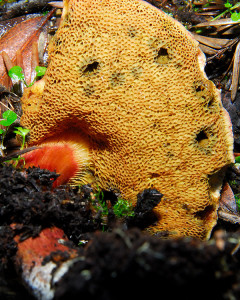
Boletes have pores beneath their caps, not gills. With this species the pores may turn blue when crushed.
Boletus truncatus is widely distributed throughout North America, and fruits between July-November. These specimens began to appear around mid-November this year.
The pileus (cap) of Boletus truncatus is broad, and convex, becoming more plane with age, and grows between 3-12 cm in diameter. The surface is very dry, not sticky at all, and develops prominent cracks on the surface of the cap during development.
The fleshy tissue of the cap of Boletus truncatus is yellow to olive-yellow in color, and the pores tend to turn a dark blue when crushed. Individual pores are irregular in shape, approximately 0.5-2 mm in width, and the pore tubes between 7-16 mm long. [1]
The spore print of B. truncatus is apparently olive-brown, but I didn’t attempt a spore print with these specimens.
The stipe (stem) grows 5-10 cm long, and up to 2 cm in width. The color is reddish, and somewhat striate along its length, becoming more yellow at the apex.
At the base a yellowish mycelium is clearly visible where the stem meets the soil.
I’m not completely confident in the absolute identity of this species, as Boletus truncatus may be impossible to distinguish, even for the experts, from its cousin Boletus chrysenteron. At least without a microscope.
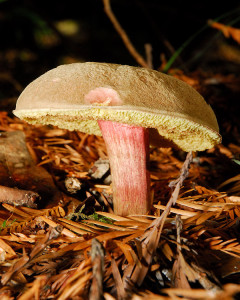
This younger specimen showed a little more pink coloration just under the cap surface than the others
It’s possible these specimens could be either species. However, it is generally accepted that Boletus chrysenteron is more likely to develop pink coloration between the cracks than B. truncatus. As such, macroscopically most of these specimens appeared to resemble the description of Boletus truncatus more closely, but any of these pictured here could prove to be either species. [2,3,4]
Although we don’t eat the fungi we find here, Boletus truncatus and Boletus chrysenteron are both considered to be edible, although Boletus truncatus is reported to be more favored, and somewhat better in flavor, but neither is considered to be a great culinary find, and may in fact be mushy and bitter. We’ll leave these for the slugs and deer to dine on.
That said though, it’s clear that some of our woodland creatures are willing to eat them. In fact, it’s been a challenge this fall to find fungi on the farm before the slugs and squirrels do!
The Boletes are definitely quite distinctive compared to the Agaric species of fungi growing here. Next time you’re on a hike, and see a mushroom growing in the woods, look closely under the cap, you might be surprised what you find underneath!
—————
[1] Alan Bessette, William C. Roody, Arleen Rainis Bessette. 2000. North American Boletes: A Color Guide to the Fleshy Pored Mushrooms. Syracuse University Press. p. 168.
[2] Boletus truncatus at Mykoweb.com
[3] Boletus chrysenteron at Mykoweb.com
[4] Boletus chrysenteron at MushroomExpert.com


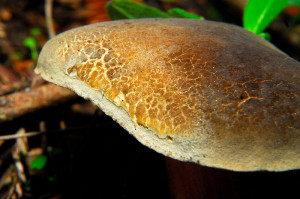
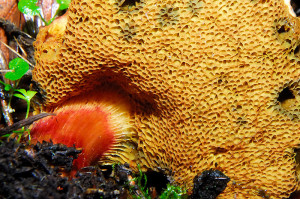
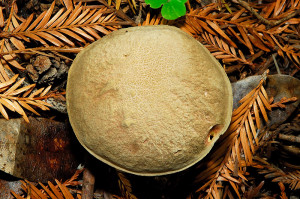
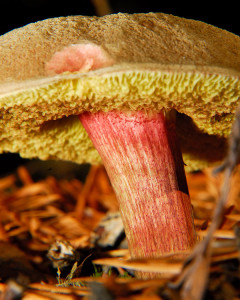
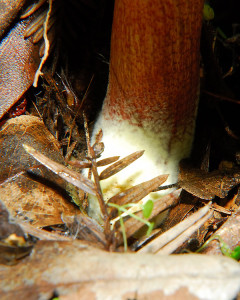

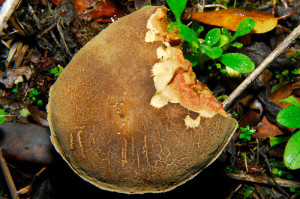
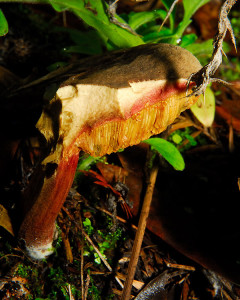







I, for one, am thrilled you’re featuring shrooms. I do chantrelle hunting up in the High Uintas east of our home. But there’s the false chantrelle. And, I’m never confident enough to actually cook up a batch of what I find ’cause I can’t tell the diff.
We occasionally see golden Chanterelles, and false Chanterelles around here. The only type of Chanterelles I’d even dare use might be the black trumpets as they’re so distinctive. That said though, I’m really not that brave and prefer to source my mushrooms from the Farmer’s Market. There are just too many look-alike species.
I’m glad to see these mushroom posts. This one is fascinating, especially when you peek underneath the cap, I had to enlarge that photo….I’m on the lookout here. I would be very excited to see one like this! Thanks for sharing all your knowledge about them.
The Boletes really are quite different. Not the most gracile, or delicate species, but interesting nonetheless. Makes a change from all the little brown mushrooms (LBMs) popping up around here at the moment! 😛
Clare, once more, I am so impressed! Beautiful pictures and explanation. Loved it.
Thanks Gloria. For the photos I think I ended up having to launder three separate pairs of jeans 😉 The photos look much better when you get down on the ground with them, but this time of year, it tends to get a little muddy!
This mushroom looks like one from a storybook, the color and shape seem so what you would think when you think mushroom. I did not know deer and squirrels eat them. I will have to take better notice when I see them to see if they are nibbled.
I didn’t realize how important wild mushrooms are for our woodland creatures until this season, everyone seems to be eating them! I have an entire folder full of photographs of ‘left-overs’ 😉 It’s really been a struggle to find some of the edible varieties intact this season. I’ve learned the hard way not to expect a prize specimen to be there tomorrow for a pic. If I want a photo, I need to be quick!
Hi Clare,
Have you considering growing your own mushrooms? Or is it a case of not wanting to release spores around your ground and potentially push out the natives?
One reason I never try picking mushrooms is as you mentioned in a comment further up; there’s just so many look alikes that I don’t want to risk anything.
I have considered growing some edibles here on purpose, I’m just not sure if I’d be able to harvest any before our resident wildlife consumes the lot! I’d have to look into setting something up to protect them. Clearly though, we seem to have the perfect weather for it! 😛
I love hearing about different types of mushrooms! At some point I want to take a class to learn about the different types. They are so interesting!
Some of the classes and conferences are really fun. It’s always easier to learn from an expert that is used to foraging for them, rather than just reading a book. An experienced mushroom hunter knows the conditions that certain fungi prefer to grow (some prefer oaks, some firs and pines etc.), and also knows which season different species grow in. 🙂
Beautiful fungi for sure, quite tempting to not eating it!
I wouldn’t eat it. Even just handling this species the texture doesn’t seem very appetizing 😉
Clare, I really love to eat mushrooms but also think they are beautiful in the woods and garden. I wish I could get them to grow where I want them but appreciate them where I find them. Carolyn
The are beautiful in the woods, and I love that they grow in fall and winter when many of the plants are dormant, so they’re not competing for my camera’s attention 🙂
Hi Clair – A great post, I learn a lot from you, thank you. I find “mushrooms” growing in my garden in Autumn usually, and love how they look. Next year I will try to ID them.
Clare I love fungi…such a fascinating thing to explore…I have always wondered about the fungi in my garden and look forward to learning more about the ones I see…
Love foraging but don’t know enough about fungi to collect them for the table. Lovely specimens though…I really love the variety of Mushrooms there are…about 2,000 I think.
I find mushrooms very interesting, but also a bit unsettling. I never touch them, sometimes knocking them over with my foot. I didn’t realize other creatures would eat them!
We have finally gotten a bit of rain (an inch or so) and I noticed a mushroom growing the other day amongst a yucca. That can’t be good! The yucca isn’t going to like that one bit!
Must be magical wandering your property and looking for the many varieties you have growing there. Thanks for sharing.
I’m sure I’ve seen mushrooms with pores underneath before as it seems familiar but I’ve never really thought that some have gills and some have pores. When I lived in deer country I always considered them the test of whether a mushroom was edible. If a deer would eat it then it was generally safe, amazing how they seem to instinctively know.
I’m quite sure my family picked and ate quite a few of these mushrooms (or their European sisters) when I was a kit. They’re great in mixed mushroom dishes, as long as you get them when they’re young. As for the other critters of the forest, it seemed that there was always such an explosion that the critters would probably get indigestion if we didn’t take a few of the mushrooms for ourselves….
informative and fascinating post. I’ll be back for more Clare.
I often wish I could identify the wild mushrooms for we do have quite a variety around the garden, but… there doesn’t seem to be enough time for everything. 😉
PS: We had to cut up our largest Galeux yesterday after discovering a soft spot on the bottom; good thing that I spotted it for when we cut into it, over 1/3 was discolored. Your ravioli recipe is on my list.
How unusual to see the underside look like a sponge.
Hello Clare, It’s probably a bit of a strange thing to say, but I think this is one of the most handsome fungi I have ever seen!
I can honestly say that almost everything I know about mushroom I have learned from you! Thanks for heightening my awareness and interest!